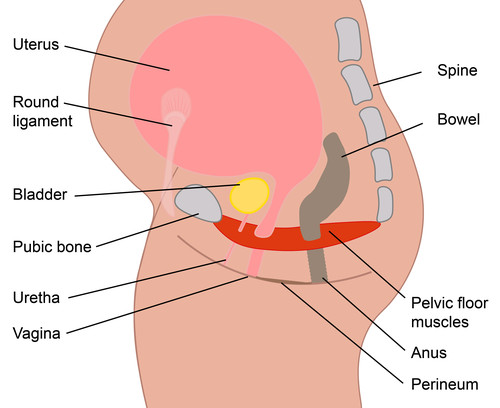Pregnancy brings about numerous changes in a woman’s body, and some of these changes can lead to discomfort. One common concern for expectant mothers is round ligament pain. If you’re experiencing aches and pains in your abdomen or groin during pregnancy, you might be wondering, “Where Is Round Ligament Pain exactly?” This article will delve into the specifics of round ligament pain, its location, symptoms, causes, and how to manage it effectively, ensuring you have a comprehensive understanding of this common pregnancy experience.
Understanding the Round Ligaments
To understand where round ligament pain is felt, it’s crucial to first know what round ligaments are. You have two round ligaments, one on each side of your uterus. These strong, cord-like structures are made of connective tissue and play a vital role in supporting your uterus, helping to keep it in place within your pelvis. Each ligament extends from the upper corners of the uterus, traveling down and outwards through the inguinal canals (passages in your groin), and attaches to the labia majora (the outer folds of the vulva). Think of them as ropes anchoring your uterus within your abdomen.
How Pregnancy Affects Round Ligaments
During pregnancy, your body undergoes hormonal changes that cause the round ligaments to become more relaxed and elastic. This increased elasticity and pliability is essential as your uterus expands significantly to accommodate your growing baby. As the uterus grows, these ligaments must stretch and lengthen to provide ongoing support. This stretching is a normal and necessary process, but it can sometimes lead to discomfort known as round ligament pain.
 Illustration showing the round ligament.
Illustration showing the round ligament.
Alt text: Diagram illustrating the anatomical location of the round ligament in a pregnant woman, highlighting its connection from the uterus to the groin area.
Pinpointing Where Round Ligament Pain Occurs
So, where exactly do you feel round ligament pain? The pain is typically felt in the lower abdomen and groin area. Because the round ligaments attach to the uterus and extend down into the groin, discomfort is usually localized along this path.
Common locations to experience round ligament pain include:
- Lower Abdomen: Pain can be felt across the lower abdomen, often extending towards the hips.
- Groin: This is a very common site for round ligament pain, as the ligaments pass through the inguinal canals into the groin area. You might feel pain deep within the groin or closer to the surface.
- Hip Area: In some cases, the pain can radiate outwards towards the hip area, as the ligaments are connected in this general region.
- One or Both Sides: While it’s more common to feel round ligament pain on the right side, it can occur on the left side or even both sides. This is because you have a round ligament on each side of your uterus.
Describing the Sensations of Round Ligament Pain
The sensation of round ligament pain can vary from woman to woman, but it is often described as:
- Sharp, stabbing pain: This is a frequently reported type of round ligament pain, often occurring suddenly with movement.
- Aching or dull pain: Some women experience a more persistent, dull ache in the lower abdomen or groin.
- Pulling sensation: As the ligaments stretch, you might feel a pulling or stretching sensation, especially during sudden movements.
- Cramping: Round ligament pain can sometimes feel like cramps in the lower abdomen.
These sensations can last anywhere from a few minutes to, in some cases, a few hours. The pain is often triggered by sudden movements, such as:
- Sudden movements: Quickly standing up, sitting down, or rolling over in bed.
- Coughing, sneezing, or laughing: These actions increase abdominal pressure, which can strain the round ligaments.
- Exercise: Certain exercises or strenuous activities can exacerbate round ligament pain.
- Prolonged standing: Standing for long periods can put extra pressure on the ligaments.
Distinguishing Round Ligament Pain from Other Pregnancy Pains
While round ligament pain is a common and generally harmless part of pregnancy, it’s important to differentiate it from other types of abdominal pain that might require medical attention.
Round Ligament Pain vs. Pelvic Girdle Pain: Pelvic girdle pain (also known as symphysis pubis dysfunction) is another type of pregnancy-related pain, but it arises from the pelvic joints becoming more relaxed and mobile. While round ligament pain is felt in the lower abdomen and groin, pelvic girdle pain is typically felt in the pelvis, lower back, and sometimes the upper thighs and perineum.
When to Seek Medical Advice: It’s crucial to consult your doctor or midwife if you experience abdominal pain accompanied by any of the following symptoms:
- Vaginal bleeding or discharge: This could indicate a more serious issue.
- Severe pain that doesn’t subside: If the pain is intense and persistent.
- Contractions, lower back pain, or pelvic pressure: These could be signs of preterm labor.
- Fever or chills: May indicate an infection.
- Lightheadedness or dizziness: Could signal a more serious problem.
- Nausea and vomiting (unrelated to morning sickness): Warrants medical evaluation.
- Difficulty walking: If the pain is so severe that it affects your mobility.
In case of heavy vaginal bleeding, severe pain, or feeling very unwell, it is essential to seek immediate medical attention by calling emergency services.
Managing and Preventing Round Ligament Pain
Fortunately, there are several strategies to help manage and even prevent round ligament pain:
- Warm compress or bath: Applying warmth to the lower abdomen can help relax muscles and ligaments, providing relief.
- Rest: Taking breaks and resting, especially lying on your side with a pillow between your knees, can alleviate pain.
- Over-the-counter pain relievers: Paracetamol is generally considered safe during pregnancy, but always consult your doctor before taking any medication.
- Supportive belly band: Wearing a maternity support belt can help support your growing uterus and reduce strain on the round ligaments.
- Gentle stretches: Regular, gentle stretches, such as hip flexion and extension exercises (after consulting your doctor or midwife), can improve flexibility and reduce pain.
- Avoid sudden movements: Be mindful of your movements and try to avoid sudden changes in position.
- Proper posture: Maintaining good posture can help reduce strain on your abdomen and ligaments.
- Avoid heavy lifting: Lifting heavy objects can exacerbate round ligament pain.
- Support during coughing or sneezing: When you feel a cough or sneeze coming on, bend forward and support your belly with your hands to minimize strain.
Reassurance and Long-Term Outlook
It’s important to remember that round ligament pain is a normal and temporary part of pregnancy for many women. It is not harmful to you or your baby. Typically, round ligament pain is most noticeable during the second trimester as the uterus is growing more rapidly. After childbirth, as your uterus returns to its pre-pregnancy size, round ligament pain usually resolves completely.
While experiencing pain during pregnancy can be concerning, understanding where round ligament pain is located and how to manage it can provide significant reassurance and help you navigate this common discomfort. Always communicate with your healthcare provider if you have any concerns about pain during your pregnancy to ensure both your well-being and your baby’s health.

